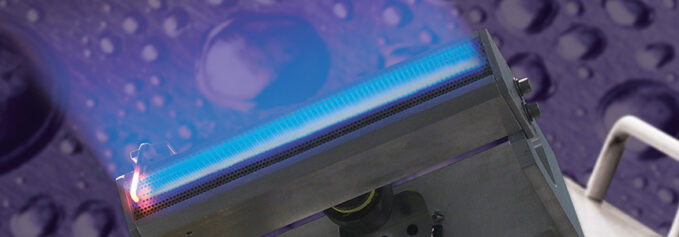
by Melissa Donovan
While digital printing opens up endless possibilities to printing direct to object, ensuring the adhesion of the ink and coatings to the surface can be challenging. This is why surface pretreatment equipment is available, which can be integrated into a manufacturing facility’s production line.
According to a press release from Plasmatreat, low surface energy and poor adhesive characteristics are the most likely cause for the inability of materials to be printed effectively, or at all. Homogenous wettability—and optimal adhesion of printing inks and coatings—is achieved only when the surface energy of the material to be printed is higher than that of the corresponding ink.
Pretreatment enables a better surface for ink to adhere to. This occurs by changing the surface tension or dyne level of the product in question. Flame, plasma, corona, and pyrosil technologies are able to transform surface energy and enable better ink adhesion.
Main Options
Ensuring proper ink adhesion to a surface can be challenging, which is why surface pretreatment equipment is available for digitally printed items. Main technology options for manufacturers that utilize digital printing technologies in house include flame, plasma, and corona; in addition to any proprietary technology out there like pyrosil.
Flame
Flame treatment is common in the digital print space. “Flame is a process where a flame oxidizes the surface. Flame treatment is used to change surface tension but less commonly known is the importance of the ratio between gas and air, which can play a key role in adhesion,” explains Sean Lanigan, president, Applied Surface Technologies, LLC.
L. Wilson Lee, director of business development, Enercon Industries Corporation, notes that flame treatment is ideal for large or heavily contoured objects, but is also effective for extremely high-speed applications.
While flame treatment is popular due to its success in activating proper adhesion, Lanigan notes that the ratio between gas and air plays an essential role in the success of the adhesion.
Plasma
Lanigan describes plasma pretreatment as the “fourth aggregation state of materials. It is an ionized gas that can interact with surfaces and forms functional groups on surfaces for bonding.”
“Pretreatment with atmospheric pressure plasma improves the adhesion of the ink to the printed object, intensifies the luminosity of the printing ink, and ensures a consistent color gradient—resulting in excellent color brilliance and a pin-sharp printed image. Improved adhesion also increases moisture and wear resistance and guarantees a long-lasting printed finish,” states a press release from Plasmatreat.
At Enercon, Lee shares two different types of plasma technology—blown arc and blown ion. “For slower application on non-conductive materials, we recommend blown arc. It creates a plasma discharge, which is effective up to seven inches wide at speeds of ten feet per minute (fpm). For faster applications, we recommend blown ion. With the Blown-ion 125, we can treat up to one inch wide at speeds of over 100 fpm. With the Blown-ion 500, we can treat up to two inches wide at the same speeds. These units can treat any material, conductive or non-conductive.”
Corona
Corona-based treatment is the process of creating ionized air between a ground roll and an electrode, according to Lee. “Film passes over the ground roll and the top side of the film is treated. The process increases surface energy to enable wettability and bonding with an ink. If printing on rolls of film, corona treating is the most economical and effective technology choice.”
Specializing in corona treatment equipment, QC Electronics, Inc. recommends bare roll corona treatment systems for digital printing. “The bare roll is the most versatile. This way you can expand your product capabilities and potential markets. You can also treat pretreated films to ensure an evenly distributed surface energy across the product. This guarantees ink clarity and is called bump treating,” explains Alyxandria Klein, marketing and sales director, QC Electronics.
Pyrosil
Pyrosil is a version of flame treatment. It uses a flame to burn chemistry, which creates SiOx and then deposits it onto the substrate/surface in question, shares Langian. Widely used in relation to glass and hollowware, it is preferred for other challenging container materials like stainless, powder coated, and aluminum that have to pass dishwashing tests. The technology is proprietary to SURA Instruments in Germany, but is available from other sources.
What is interesting about pyrosil and flame is that sometimes a system can utilize both. “Flame treaters are popular options due to their range of applicable materials and some of the systems can be dual purpose—flame and/or pyrosil. For example, some plastics may only require a flame treatment while the combination of flame and pyrosil treatment can help when printing to glass,” notes Michael Perrelli, marketing director, INNOVATIVE Digital Systems (IDS).
Surface Type
Considering popular surfaces that are digitally printed on—glass, plastic, metal, and wood—it’s important to understand which pretreatment solution would work best and why. However, while normally it’s important to drilldown to specifics such as surface type, it’s actually more of a consideration whether the object is dimensional versus flat. Other factors also come into play.
Perrelli notes the importance of asking the right questions while dialing in the settings needed to achieve optimal adhesion. “For example, does a specific material require flame only? In the case of drinkware, how many revolutions or turns does the product make? Is there a wipe-on product that should be applied prior to printing?
There are slight differences to the process steps to achieve rock-solid adhesion,” he adds.
Flat surfaces benefit from corona treatment. “Corona treatment is great for any type of adhesion process that requires a balanced surface energy throughout the surface of the material. The great thing about corona treatment is that the corona field is even and balanced. This means the product will have a balanced surface energy throughout the entire surface of the product. With other treatment processes, it is harder to achieve an evenly distributed surface energy,” explains Klein.
Both flat and dimensional surfaces fair well with plasma treatment. According to Plasmatreat, this is true even when it comes to difficult to adhere to surfaces like polypropylene (PP), polyethylene (PE), polyamide, polycarbonate, glass, or metal.
Speaking of specific surface types, Lanigan recommends that “many plastics can be treated with standard flame but some of the low surface energy plastics like PP or PE may require pyrosil, plasma, or corona.” Glass on the other hand, while usually treatable with standard flame, if it must mass dishwashing tests, pyrosil is the best pretreatment.
Metal is a completely different story. “UV ink adhesion to metals can be affected by the metal finish—polished, matte, or brushed—but generally the rougher the surface, the more flexible the pretreatment, so it may not require any pretreatment. While a polished surface may require flame and an adhesion promoter. Keep in mind that metals may have a coating over the surface, which then becomes the printing surface, not the metal itself,” suggests Lanigan.
Wood is an interesting surface to consider. Perrelli says that flame treating isn’t very common when wood is involved and notes that “the one thing you must keep in mind when printing to wood is the coating on the product. That coating is ultimately what you are printing to and you should treat it as such.”
“Untreated wood normally doesn’t require any treatment but if it is coated with a varnish, polyurethane, or a thermoplastic, the surface is no longer wood and so the actual surface must treated and not the underlying wood,” agrees Lanigan.
For Lee, it’s a combination of the type of surface—dimension and material, the physical area to be treated, and the speed of the printing process that determines pretreatment. “For slower, larger printing applications, plasma blown arc is the best option. For faster applications, plasma blown ion systems are more effective because of a higher ion density, which reduces the required dwell time.”
Despite the intended material to be printed on, Lanigan recommends properly cleaning the surface prior to pretreatment as well as keeping an open mind about adding adhesion promoters and/or primers. “It is always necessary to start with a clean surface and then surface tension may have to be increased. The best choice is always the least expensive option, which can be integrated into the printing process as long as it works. It is very important to remember that regardless of pretreatment, some applications and substrates also require an additional adhesion promoter/primer. This is an another step and not desired but some UV digital printing applications require it.”
Lifespan and Price of Device
Depending on the level of use, surface pretreatment devices may last years. It’s easy to continue working with an original system in house as long as routine maintenance is conducted.
“The lifespan of treatment is dependent on many factors including the material, what type of exposure to contamination, and the durability required,” notes Lanigan. In his experience, flame systems can easily last 25 years or more with simple maintenance.
Enercon plasma devices have been running for over 30 years. However, Lee says even if this lifespan is possible, it is somewhat unusual. “In most cases either a customer’s application parameters change or updates in technology dictate a change to improve efficiencies.”
Depending on whether the device is used for research and development (R&D) or full production runs, the lifespan may also differ. QC has many customers that use corona treatment for R&D. “In this case, the lifespan is much longer due to the fact that they are not running the unit full time, only tests,” explains Klein.
Placing a pretreatment system into a manufacturing facility is an investment, no doubt, so the capital expenditure a company requires to purchase equipment is considerable but taking into account the long lifespan of these devices more than makes up for it.
“The initial investment range can be wide. Many of the capable systems that we are familiar with come in around the $25K mark. The free-standing units in this range offer consistency of treatment from part to part along with the speed to keep up with multiple digital printers. The actual treatment costs could be as low as a few cents per part but that all depends on the size of the product and treatment area,” admits Perrelli.
Plasma systems for treating objects may range from $8K to $40K for a single system, according to Lee. Rare, custom systems for unique applications can escalate into hundreds of thousands of dollars. Corona treaters for polymer films can range from $10K to hundreds of thousands of dollars depending on the size of the system, power needed, and options included.
Turnkey vs. Bespoke
Pricing is interesting because it is largely based on various components that go into a system. Depending on the print process, production facility, and other requirements there are options for purchasing either a turnkey surface pretreatment device or something considered more bespoke.
“The product being decorated or overall production demand will dictate that decision and it is something that appears early in the discovery/research phase. Perhaps a current system can be adjusted by the manufacturer to fit a unique need instead of building a new system from the ground up,” suggests Perrelli.
Tweaking an off-the-shelf system is common. “Turnkey solutions are always the most economical but custom systems or semi-custom systems are more common. Related to flame and pyrosil, we find that customers may need a minimum/maximum length or height of treatment area, so we can use an off-the-shelf treatment system and burner length but then we may have to customize the conveyance process, in feed/out feed, etc.,” explains Lanigan.
According to Klein, a few different elements of a corona treatment process determine whether or not a turnkey piece of equipment needs to be altered in any way. “Every process and material requires a certain corona treater, whether that be bare roll, covered roll, sheet treatment, web treatment, lab treatment, one or both sides treated, etc. Some processes are unique and require a custom treater. For example, extremely thin film is difficult to treat without assistance of something like a vacuum table. Some special films also require what’s called a hybrid corona treater. ”
When in comes to where to place the pretreatment mechanism, Lee believes it is best to surface treat inline, prior to printing. “This ensures a fresh high-energy surface optimized for wettability and adhesion. Therefore, integration of the treatment is usually in very close proximity to the printing process.”
But again, whether placed inline, offline, or near line is dependent of the type of surface/material being treated. For example, corona treatment of roll-to-roll films is usually “integrated as part of a complete printing process either by the OEM of the printing equipment or by the end user, if being added to an existing line,” explains Lee.
“For object treating, the plasma discharge heads are simple to integrate into a printing operation, as in most cases the surfaces being printed are already being transported under a printhead by some means. The plasma treater’s nozzle is a secondary operation prior to printing. It is also possible to integrate plasma systems with indexing systems and robotics if needed; where either the object is presented to the plasma nozzle or the plasma nozzle is moved by the articulating equipment,” continues Lee.
Part of the Puzzle
In an age where digital printing is toted as the technology that allows anything to be directly printed to, surface pretreatment options are an important part of the puzzle. Flame, plasma, corona, and pyrosil are options when it comes to ensuring a successful adhesion of ink to a low density or low dyne level surface. Visit industrialprintmagazine.com/webinars to view an archived broadcast on the topic.
Oct2021, Industrial Print Magazine



